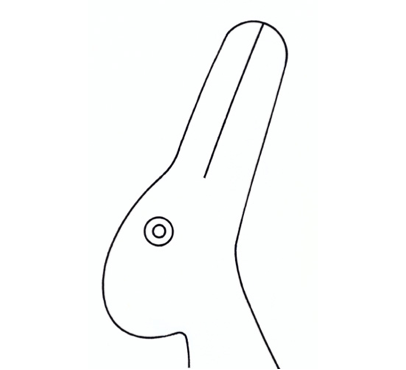 Quick – which did you see — a duck or a rabbit?
Quick – which did you see — a duck or a rabbit?
What you just experienced was a gestalt system in action or more specifically the principal of Multistability.
However, what should really have your attention is this: if a simple black & white line drawing can represent two entirely different meanings without so much as moving a pixel, how can you know if your marketing photos, line art, charts, etc, are actually conveying your intended message to your customer?
And if they’re not, is that hurting the effectiveness of your marketing?
How To Build More Effective Ads & Websites
 What if I told you that 50% of your audience actually interprets your images in the wrong way? Instead of seeing this professionally shot photo of a couple lounging in bed as relaxation, which is the central theme to your marketing campaign, they instead see it as escapism – which is their key booking motivator but not mentioned anywhere in any of YOUR marketing materials?
What if I told you that 50% of your audience actually interprets your images in the wrong way? Instead of seeing this professionally shot photo of a couple lounging in bed as relaxation, which is the central theme to your marketing campaign, they instead see it as escapism – which is their key booking motivator but not mentioned anywhere in any of YOUR marketing materials?
Don’t think that is possible? Think again. In fact, in one research study if the audience had children in the household, they saw this image as escape vs relaxation. Wow right?
Would that effect your click-thru rates? Would it effect your conversion rates or maybe your time-on-site or landing page bounce rates?
Would you like to know how to fix this? Sure you would.
But before we get to that… close your eyes for 15 seconds, scroll back to the top of this post and when you open them, look directly at the image again. Then come back here.
What did you see this time? Yep, research says that most likely you’ll see the same image you saw the first time.
While you can force your brain to see the other image, your default is either a duck or a rabbit. That’s a key point that you have to understand here… while your audience CAN interpret your image the way you want them to, prospects will DEFAULT to to THEIR INTERPRETATION.
You can’t change that… it’s biologically burned into their DNA. So what’s a poor marketing boy to do?
Well the first thing is to CHANGE THE WAY YOU CREATE MARKETING MATERIALS.
Image Perception Mapping Research
There are two ways agencies and clients try to overcome this limitation. The first, and by far most commonly used technique is the focus group.
*Collective groan* yes, that bastion of marketing, the focus group. Where we herd in folks that really aren’t like our target audience, but will claim to be for a little money and unlimited M&M’s, into a small room with two-way mirrors. We cart in a few dozen, that’s right, a few dozen and based on the opinions of those oh so well informed, representative consumers we make multi-million dollar creative decisions on our ads, brochures, sales kits and websites.
But isn’t there a better way? Can’t we use technology and the Internet to come up with something better?
Yes. Yes I believe that we finally can use technology, specifically Pinterest and its new Private Board feature to leave focus groups behind. Using Pinterest’s private board feature and inviting a random customer sample to help us, we can reverse engineer the right images for our marketing. NOTE – I said IMAGES as in plural. Because there is likely no one image that will be universal to all of your customer base. You’ll need to think about using the output of this kind of consumer marketing research differently. You won’t be making one ad, brochure or website page, you’ll likely be creating multiple versions based on prospect personas.
So, are you interested in finding our how to do this?
I don’t mean at a high level, gotta hire Converse Digital to actually pull it off kind of way. I mean, are you interested in peeking behind the curtain to see the nuts and bolts of building a process to scientifically conduct this kind of consumer research?
If you’re are interested in learning how to conduct an Image Perception Mapping study yourself, keep reading.
Using Pinterest For Consumer Research [Case Study]
Now that I know you’re truly interested in learning how to create more effective marketing materials, let’s get started.
First, because I’m a believer in showing not telling as a way of convincing folks to believe, I’m not going to show you someone else’s case study.
No, together, we’re going to create a case study of our own and because you’ll be helping to create it, you’re going to get exclusive rights to see the study before anyone else.
Now this is going to take a little bit of time on your part. Nothing too hard, but you’re going to have to help me help you…Ok?
Ok, so if you’re still with me and still wanting that exclusive access, take step one.
Give me your name and the email address you use to access Pinterest. If you don’t have a Pinterest account, go create one. It’s ok, I’ll wait. But it’s imperative that you give me the same email address that you use for Pinterest or I can’t invite you to play along.
This research was conducted in 2012. To request a copy of the findings, please provide the necessary information below and we’ll send you a link to watch the final case study presentation.
[gravityform id=”13″ name=”Visual Palette” title=”false” description=”false”]
Second, now that you’ve signed up, you’re going to get a few emails from me with explicit instructions for joining the case study group. These emails will give you access to the private boards I’ve created, instructions for what your role is, and finally, a timeline for completion of the case study.
Third, the final step in our journey is the case study itself. I’ll be compiling all of the data into a single presentation deck that I’ll share with you AND ONLY YOU.
That’s right. While one day that deck will see the light of day, for at least the foreseeable future, you’ll be the ONLY one who has access to the information, process and step-by-step instructions for creating your own Image Perception Mapping study. I mean, it’s the least I can do considering you were interested enough to take this journey with me.
In the meantime, feel free to post any questions or comments here and I’ll be sure to get right back to you.


I LOVE this! Thank you so very much for opening this up to your community! I am so very much looking forward to this Tom and the results.
As always the best we get from you!
Suzanne
Thanks Suzanne. I’m excited to see Pinterest finally do this — I’ve been waiting for months hoping they’d activate just this feature… be sure to spread the word as the more folks we have in the test group the more valuable and reliable the outcome will be for all of us.
Thank you for the invite.
Would love to have you Tracey….
Tom, this is a fantastic idea.
At Curalate, it’s been a pleasure to work with some of the world’s largest agencies, like Group M Next, Edelman, and Ogilvy. I’d love to connect to see if there’s any way we can possibly work together. Feel free to drop me a line at Brendan@Curalate.com.
Thanks,
Brendan
Thanks Brendan,
I’ve used the approach (many moons ago) with great results but it all had to be done offline. So it will be interesting to see if I get similar or different results now that I can do it online via Pinterest. Be sure to sign up to play along… should be painless and fun.
Tom – “How To Use Pinterest For Ethnographic Customer Research” is a very cool idea, but seems more like A/B testing than Ethnography? More will be revealed and I’m interested to see your updates. Good luck
Adam,
Thanks for stopping by and yes, I think once you’re inside the experiment you’ll see it’s not A/B testing… may be stretching the ethnography definition a bit or not, but having done this in the offline world and seeing the results, it’s pretty darn cool.
Now to see if we can pull it off via a Pinterest board — well we’ll see. It may or may not really work like it does in the offline world but then, that’s why we conduct digital R&D isn’t it?
Love this idea!
Thanks Nia! I’m really looking forward to seeing how it turns out. Always love Digital R&D…